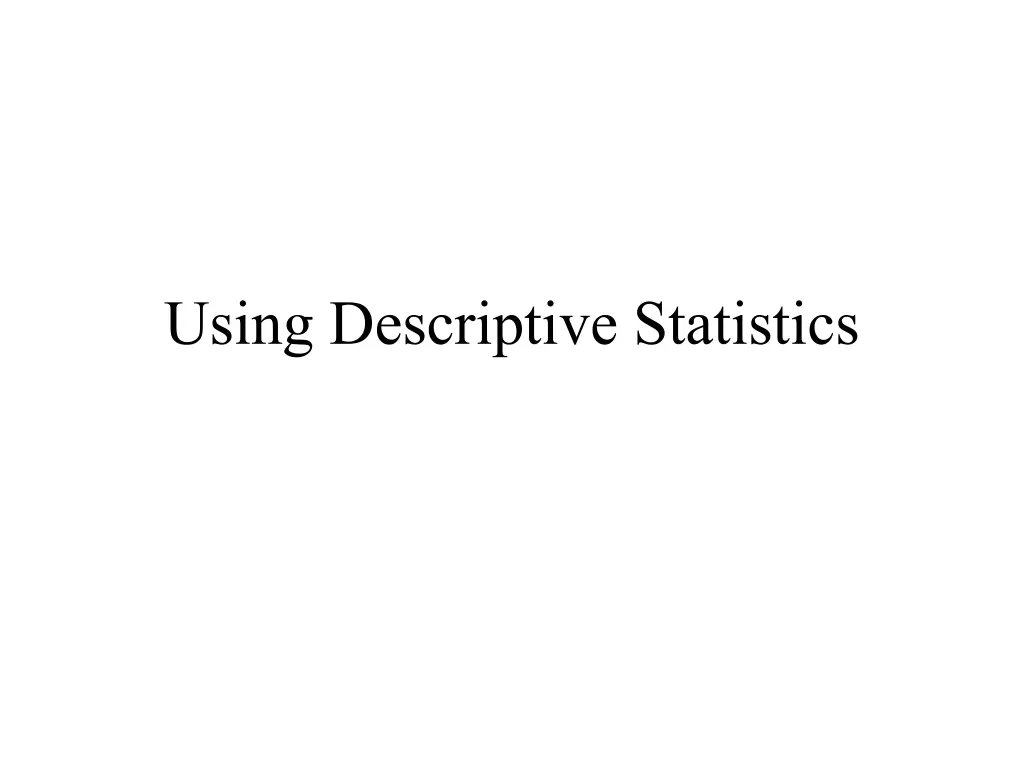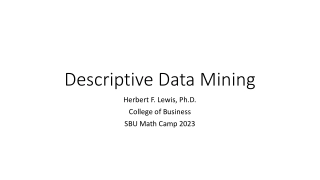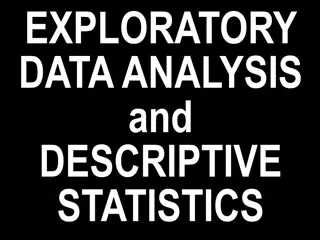
Understanding Descriptive Statistics and Data Analysis
Learn about populations and samples, parameters and statistics, measures of central tendency, variability, and sorting data based on characteristics. Explore nominal variables and their significance in data analysis.
Download Presentation

Please find below an Image/Link to download the presentation.
The content on the website is provided AS IS for your information and personal use only. It may not be sold, licensed, or shared on other websites without obtaining consent from the author. If you encounter any issues during the download, it is possible that the publisher has removed the file from their server.
You are allowed to download the files provided on this website for personal or commercial use, subject to the condition that they are used lawfully. All files are the property of their respective owners.
The content on the website is provided AS IS for your information and personal use only. It may not be sold, licensed, or shared on other websites without obtaining consent from the author.
E N D
Presentation Transcript
Populations and Samples Parameters: summarizing the characteristics of individuals in the population Population (everybody) Sample Statistics: summarizing the characteristics of individuals in the sample
Definitions A population represents all of the individuals in a group to which you wish to generalize. Since we can not know everyone in a population we study samples intended to represent the population. Summaries of the measures of the characteristics of individuals in the population are called parameters. Summaries of the measures of the characteristics of individuals in the sample are called statistics.
Populations and Samples If we know everyone in the population then there is no need to guess at the summaries of the characteristics Population (everybody) Since samples are a subset of the population, sample summaries are used as a best guess (estimate) of the summaries of the population characteristics Sample
Parameters and Statistics Summaries of the measures of characteristics of individuals in a group Measures of Central Tendency The way in which data clusters around a central point Measures of Variability The degree to which data are spread away from the measure of central tendency
You first learned this in middle school: Measures of Central Tendency Mode the response that occurs most frequently Median the point where half of the scores are above and half below Mean average
Sorting Data on Characteristics Imagine a series of containers and your job is to take each piece of information and place it in one and only one appropriate container. There are 3 ways to do this.
Nominal Variables The containers have no logical order. The order of the containers conveys no information. Allows comparison of group size. Which container has the most in it? Mode is the only measure of central tendency that can be used. Orange Brown Green Red Yellow Blue
Ordinal Variables The containers have a logical order. The order of the containers conveys information. Although the containers are in order the distance between the contains may not be equal. Median is the measure of central tendency that conveys the most information. Mode can be used also. Rarely Seldom Occasionally Half the Time Usually Almost Always
Interval Variables The containers have a logical order. The order of the containers conveys information. The containers are in order and the distance between the contains is equal. Mean is the measure of central tendency that conveys the most information. Mode and median can be used also. 1 inch 2 inches 3 inches 4 inches 5 inches 6 inches
A Special Case of Interval Scales Non-Ratio Scales Interval scales that have no zero point. Most measures of cognitive ability are non-ratio scales. It is not appropriate to make ratio statements about measures of cognitive ability.
Ratio Scales When zero on an interval scale represents an absence of the thing being measured it is called a ratio scale. i.e., 80 centimeters is twice as long as 40 centimeters. You are unlikely to ever statistically deal with ratio and non-ratio scales differently but it still important to know the difference to avoid making ratio statements about non-ratio data.
Measures of Variability (nominal) Since nominal variables are often used as grouping variables (independent) reporting variation is not important Nominal scales use measures of dispersion Index of Qualitative Variation (IQV): 0 (all in one container to 1 (equal in all containers) Search for IQV calculator
Measures of Variability (ordinal) Range: distance between high and low value OR Quartiles: split the ordered data into 4 equal sized groups (the same number in each group) Report the inter-quartile range (IQR): 25% point to 75% point median equals 10 (IQR = 7-15). Note that the median will not necessarily be half way between the 25% and 75% points.
Measures of Variability (interval) Standard deviation Compute the average distance that all responses are from the mean
10 9 Same sample size. Approximately the same mean. 8 7 6 5 Which one has the larger standard deviation? 4 3 2 1 0 10 14 18 22 26 30 34 38 42 46 50 54 58 62 66 70 10 9 8 7 6 5 4 3 2 1 0 10 14 18 22 26 30 34 38 42 46 50 54 58 62 66 70
Reporting Descriptive Statistics In general, three numbers are always reported Measure of central tendency Measure of variability Sample size If the statistics from one or two groups are being reported, you may want to report these in the body of the text. For more comparisons report statistics in a table.
Tables for Interval Data Table 1 Mean Age and Standard Deviation of Middle School Students by Grade Level on the First Day of School Grade Level N Mean SD 6th 124 11.62 .67 7th 119 12.75 .72 8th 104 13.91 .93
What to remember? Relationship of population, sample, parameter, and statistic Measures of central tendency Mean, median, mode Variable types Nominal, ordinal, interval (ratio) Measures of variability IQV, inter-quartile range, standard deviation
Populations and Samples If we know everyone in the population then there is no need to guess at the summaries of the characteristics. Population (everybody) Since samples are used to develop estimates of the parameters, sometimes the statistics need to be adjusted to improve the estimates. Sample
Computing Standard Deviation of a Population Standard Deviation = X = mean n = number of scores = sum (in this case, the sum of the differences of each score from the mean, squared) The square root of the sum of squared differences divided by the group size.
Computing Standard Deviation of a Sample Standard Deviation = Degrees of freedom df X = mean n = number of scores = sum (in this case, the sum of the differences of each score from the mean, squared) The square root of the sum of squared differences divided by the degrees of freedom Adjusted population estimator






















